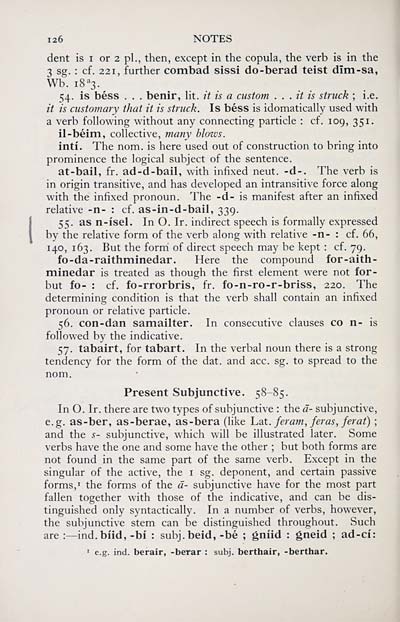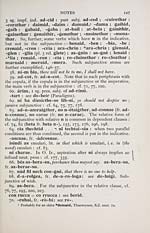Download files
Complete book:
Individual page:
Thumbnail gallery: Grid view | List view

126 NOTES
dent is I or 2 pl., then, except in the copula, the verb is in the
3 sg. : cf. 221, further combad sissi do-berad teist dim-sa,
Wb. 18 ='3.
54. is béss . . . benir, Ht. it is a custom . . . it is struck ; i.e.
it is ciistomary that it is struch. Is béss is idomatically used with
a verb following without any connecting particle : cf. 109, 351.
il-béim, collective, matiy blows.
intí. The nom. is here used out of construction to bring into
prominence the logical subject of the sentence.
at-bail, fr. ad-d-bail, with infixed neut. -d-. The verb is
in origin transitive, and has developed an intransitive force along
with the infixed pronoun. The -d- is manifest after an infixed
relative -n- : cf. as-in-d-bail, 339.
55. as n-ísel. In O. Ir. indirect speech is formally expressed
by the relative form of the verb along with relative -n- : cf. 66,
140, 163. But the forní of direct speech may be kept : cf. 79.
fo-da-raithminedar. Here the compound for-aith-
minedar is treated as though the first element were not for-
but fo- : cf. fo-rrorbris, fr. fo-n-ro-r-briss, 220. The
determining condition is that the verb shall contain an infixed
pronoun or relative particle.
56. con-dan samailter. In consecutive clauses co n- is
followed by the indicative.
57. tabairt, for tabart. In the verbal noun there is a strong
tendency for the form of the dat. and acc. sg. to spread to the
nom.
Present Subjunctive. 58-85.
In O. Ir. there are two types of subjunctive : the d- subjunctive,
e.g. as-ber, as-berae, as-bera (like Lat. feram, feras, ferat) ;
and the s- subjunctive, which will be illustrated later. Some
verbs have the one and some have the other ; but both forms are
not found in the same part of the same verb. Except in the
singular of the active, the i sg. deponent, and certain passive
forms,' the forms of the á- subjunctive have for the most part
fallen together with those of the indicative, and can be dis-
tinguished only syntactically. In a number of verbs, however,
the subjunctive stem can be distinguished throughout. Such
are :— ind.bíid, -bí : subj.beid, -bé ; gníid : gneid ; ad-cí:
■ e.g. ind. berair, -berar : subj. berthair, -berthar.
dent is I or 2 pl., then, except in the copula, the verb is in the
3 sg. : cf. 221, further combad sissi do-berad teist dim-sa,
Wb. 18 ='3.
54. is béss . . . benir, Ht. it is a custom . . . it is struck ; i.e.
it is ciistomary that it is struch. Is béss is idomatically used with
a verb following without any connecting particle : cf. 109, 351.
il-béim, collective, matiy blows.
intí. The nom. is here used out of construction to bring into
prominence the logical subject of the sentence.
at-bail, fr. ad-d-bail, with infixed neut. -d-. The verb is
in origin transitive, and has developed an intransitive force along
with the infixed pronoun. The -d- is manifest after an infixed
relative -n- : cf. as-in-d-bail, 339.
55. as n-ísel. In O. Ir. indirect speech is formally expressed
by the relative form of the verb along with relative -n- : cf. 66,
140, 163. But the forní of direct speech may be kept : cf. 79.
fo-da-raithminedar. Here the compound for-aith-
minedar is treated as though the first element were not for-
but fo- : cf. fo-rrorbris, fr. fo-n-ro-r-briss, 220. The
determining condition is that the verb shall contain an infixed
pronoun or relative particle.
56. con-dan samailter. In consecutive clauses co n- is
followed by the indicative.
57. tabairt, for tabart. In the verbal noun there is a strong
tendency for the form of the dat. and acc. sg. to spread to the
nom.
Present Subjunctive. 58-85.
In O. Ir. there are two types of subjunctive : the d- subjunctive,
e.g. as-ber, as-berae, as-bera (like Lat. feram, feras, ferat) ;
and the s- subjunctive, which will be illustrated later. Some
verbs have the one and some have the other ; but both forms are
not found in the same part of the same verb. Except in the
singular of the active, the i sg. deponent, and certain passive
forms,' the forms of the á- subjunctive have for the most part
fallen together with those of the indicative, and can be dis-
tinguished only syntactically. In a number of verbs, however,
the subjunctive stem can be distinguished throughout. Such
are :— ind.bíid, -bí : subj.beid, -bé ; gníid : gneid ; ad-cí:
■ e.g. ind. berair, -berar : subj. berthair, -berthar.
Set display mode to: Large image | Transcription
Images and transcriptions on this page, including medium image downloads, may be used under the Creative Commons Attribution 4.0 International Licence unless otherwise stated. ![]()
| Early Gaelic Book Collections > Matheson Collection > Old-Irish paradigms and selections from the Old-Irish glosses > (142) |
|---|
| Permanent URL | https://digital.nls.uk/80951263 |
|---|
| Description | Items from a collection of 170 volumes relating to Gaelic matters. Mainly philological works in the Celtic and some non-Celtic languages. Some books extensively annotated by Angus Matheson, the first Professor of Celtic at Glasgow University. |
|---|
| Description | Selected items from five 'Special and Named Printed Collections'. Includes books in Gaelic and other Celtic languages, works about the Gaels, their languages, literature, culture and history. |
|---|

